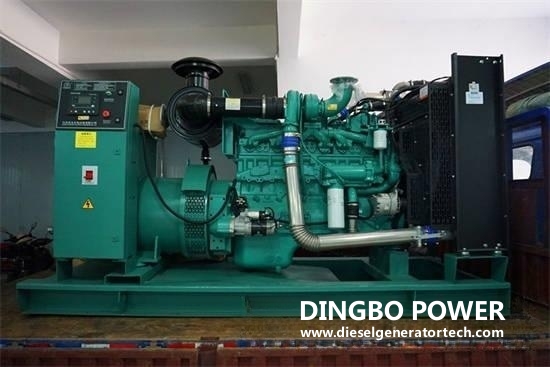With the continuous improvement of economic level, people's pace of life is speeding up. In order to meet the requirements of high-speed and efficient work, the structure of high-speed synchronous Cummins with Stanford generator is to use a hidden pole rotor and set a special cooling system.

1. Implicit pole rotor: the outer surface is cylindrical, and the cylindrical surface is grooved to place the DC excitation winding, and fastened with metal slot wedges, so that the motor has a uniform air gap. Because of the huge centrifugal force when rotating at high speed, the rotor is required to have high mechanical strength. Implicit pole rotor is generally forged into a whole piece of high-strength alloy steel, and the slot shape is generally open for installation of excitation winding. About 1/3 of each pole distance is not grooved, forming big teeth; The rest of the teeth are narrow and called small teeth. The center of the big tooth is the center of the rotor magnetic pole. Sometimes the big teeth also open some small ventilation slots, but the windings are not embedded; Sometimes, narrow and shallow small grooves are milled at the bottom of the wire slot as ventilation grooves. A metal retaining ring and a central ring are also installed at the axial ends of the rotor body of the non salient pole rotor. The retaining ring is a thick walled cylinder made of high-strength alloy to protect the end of excitation winding from being thrown out by huge centrifugal force; The central ring is used to prevent the axial movement of the winding end and support the retaining ring. In addition, in order to connect the excitation current to the excitation winding, the generator shaft is also equipped with a collecting ring and a brush.
2. Cooling system: since the energy loss in the generator is proportional to the motor volume, its magnitude is proportional to the third power of the motor linearity, while the magnitude of the generator cooling surface is only the second power of the motor linearity. Therefore, when the size of the generator increases (due to the limitation of materials, it is necessary to increase the size of the generator to increase its capacity), the heat required to be emitted per unit of surface of the generator will increase, and the temperature rise of the generator will increase. In a high-speed turbogenerator, centrifugal force will cause a huge tangential stress on the rotor surface and the rotor center hole surface. The larger the rotor diameter is, the greater the stress is. Therefore, the diameter of the rotor body of the 2-pole turbo generator shall not exceed 1250mm within the allowable stress limit of the forging material.
To increase the capacity of a large turbine generator, it is necessary to increase the length of the rotor body (that is, use a slender rotor) and increase the electromagnetic load. At present, the rotor length can reach 8m, which is close to the limit. To continue to increase the capacity of a single machine, the only way is to increase the electromagnetic load of the motor. This makes the heating and cooling problems of large turbine generators become particularly prominent. To this end, a variety of cooling systems have been developed. For the steam turbine generator below 50000 kW, the closed air cooling system is mostly used, and the fan in the generator is used to blow the heating parts to cool down. Hydrogen cooling is widely used for generators with a capacity of 500000-600MW. The heat dissipation performance of hydrogen (purity 99%) is better than that of air. Replacing air with hydrogen not only has a good heat dissipation effect, but also can greatly reduce the ventilation friction loss of the motor, which can significantly improve the efficiency of the generator. However, hydrogen cooling must be provided with explosion-proof and leak proof measures, which makes the motor structure more complex and increases the consumption and cost of electrode materials. In addition, liquid medium can also be used for cooling. For example, the relative cooling capacity of water is 50 times that of air, which takes away the same heat. The flow of water is much smaller than that of air.
Therefore, using a part of hollow conductor in the coil and cooling the conductor with water can greatly reduce the temperature rise of the generator, delay the aging of insulation and increase the service life of the generator. Some countries around the world have also widely used water internal cooling technology in large capacity generators, and produced hundreds of thousands to more than one million kilowatts of giant generators. In addition to water cooling, the liquid cooling medium can also use transformer oil. Its relative thermal conductivity is about 40% of water, and its insulation performance is good, which can increase the rated voltage of the generator to tens of thousands of volts, thus saving the investment in the step-up transformer.
In recent years, researchers in the generator industry are also developing evaporative cooling technology using Freon as the coolant. Due to the good insulation performance of Freon, it is easy to be gasified. The principle of its gasification latent heat can be used to cool the generator. In the future, it is a meaningful exploration direction.
As a professional diesel generator manufacturer, we always insist on using first-class talents to build a first-class enterprise, create first-class products, create first-class services, and strive to build a first-class domestic enterprise. If you would like to get more information welcome to contact us via [email protected].
Copyright © Guangxi Dingbo Generator Set Manufacturing Co., Ltd. All Rights Reserved | Sitemap
Update cookies preferences